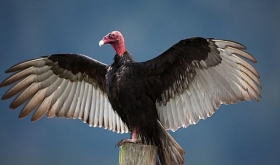
Turkey Vulture
Cathartes aura
Animal Behavior: Turkey vultures usually roost in large community groups, but search for food independently during daylight hours. Groups as large as several hundred vultures have been observed to roost together, sometimes including black vultures. Populations in colder areas migrate seasonally to warmer weather.
Eating Habits: Turkey vulture diets vary depending on their habitat. Vultures living around agriculture feed mainly on the carrion of domestic animals, mostly livestock. They also rely heavily on roadkill in areas of human development. A study in South Carolina found that in non-agricultural areas, their primary source of food was wild carrion. Turkey vultures preferentially feed on smaller carcasses but will feed on dead animals of any size. They prefer freshly dead carcasses but cannot get through the thick skin of larger animals, so must wait for some decay to enable entering body cavities. To find their food they rely on their keen sense of smell and vision. They are one of the few bird species that has an acute sense of smell. In some cases, turkey vultures have been seen eating rotten fruits and vegetables and occasionally they prey on insects, reptiles, or bird nestlings. Turkey vultures have also been observed eating coyote and domestic animal dung.
Range: Turkey vultures occupy a diverse range of habitats. They are found in forested as well as open environments. Turkey vultures can be found anywhere they can effectively find a carrion food supply. They are easily habituated to humans and human development.
Conservation Efforts: Turkey vultures are a common species throughout their range. They are listed as a species of Least Concern.
Animal Facts: Depending on the subspecies, turkey vultures vary from 0.85 to 2 kg and can have a total length between 64 and 81 cm. Sexes do not differ, all have a brownish black plumage with a bare head and neck. The head and neck skin color can vary from pink to bright red. Turkey vultures are commonly mistaken for black vultures. However, they can be distinguished by their grey primary and secondary feathers and their black head and neck color. Based on their wing surface to weight ratio, turkey vultures have light wing loading. This makes them more buoyant in air than other vultures and better able to utilize thermals to help them stay in flight with minimal energy usage.
